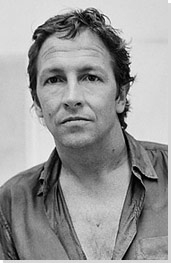BED.
 |
| 'BED' |
In the 1950's Rauschenberg's "combine" piece named 'Bed', was one of the first of its kind. The invention of the "combines" is said to have started when Rauschenberg ran out of canvas and decided to turn his bed linens into art instead. The artist began by drawing on the pillow and quilt with pencil, then he quickly dropped and slopped paint onto them. He then placed the bed linens to cover a rectangular wooden backing. The BED appearance was further emphasised when the artist fixed the quilt and pillow in the way a BED would typically look if one corner was un-tucked. It is believed that the artist was inspired by Jackson Pollock and Willem de Kooning because of the similar style of loose dripping of paint.
It's clear that the artist was showing the relationship between his own daily life objects and his art interests in one piece. Rauschenberg almost intensely created a split down the middle showing that art (above part) is much brighter and exciting than typical everyday objects. From my opinion, he's stating that art has improved his daily life because I find the art part more interesting than the plain, untouched bottom part. The paint seems to be concentrated around the area the head rests whilst sleeping, so I assume that the artist is trying to state we are most artistic when we sleep in our life.
 |
| Jackson Pollock 'Autumn Rhythm' |
It's clear that the artist was showing the relationship between his own daily life objects and his art interests in one piece. Rauschenberg almost intensely created a split down the middle showing that art (above part) is much brighter and exciting than typical everyday objects. From my opinion, he's stating that art has improved his daily life because I find the art part more interesting than the plain, untouched bottom part. The paint seems to be concentrated around the area the head rests whilst sleeping, so I assume that the artist is trying to state we are most artistic when we sleep in our life.
Rauschenberg's combines further developed, and with that the world became amazed by the strangness, unqiuness and challengin the ordianry nature of them. Monogram is one of Rauschenberg's most famous pieces, becuase he took the combines concept and further developed. The merging of painting and sculpture went from the wall e.g BED to a pedestal. He began trying to be traditional with the use of materials such as using oil on a streched canvas. However, soon left that idea and turned to adding a wide variety of unsual and eveyday objects on top of the painting, to create a far more three-dimensional combine piece, then the BED. Rauschenberg often told people that his artwork was lot of the time based on walking around New York City and finding abandoned items, such as this stuffied angora goat that dictated this piece entirely. Paint was applied to the goat like the BED combine around the snout in a abstract expressionsit manner. More objects, such as a tennis ball, metal, wood plank and a tire was added, further removing any trace of ordianry from this piece.



No comments:
Post a Comment